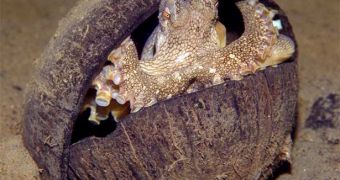Over the years, scientists have been forced to rethink their theories that held only humans and primates could use tools. Rodents, birds and even elephants were proven to be able to do this as well, albeit to a smaller extent, and now octopi are added to the list as well. Recent observations have revealed that an octopus is perfectly capable of drawing on the safety of a discarded coconut shell and using it as a mobile armor as it moves over seafloors. The new discovery was made by accident, the scientists behind it say, quoted by LiveScience.
The target of the accidental observation was the veined octopus (Amphioctopus marginatus), which was found to be collecting halves of coconut shells, and then stacking them neatly on top of each other. It would then put its eight arms over the entire ensemble, and stiffen the tentacles shortly afterwards. With its “collection” securely gripped, it would then begin to move on the bottom of the sea, and carry all the shells with it, for later use as a mobile home or armor.
“While I have observed and videoed octopuses hiding in shells many times, I never expected to find an octopus that stacks multiple coconut shells and jogs across the seafloor carrying them. I could tell that the octopus, busy manipulating coconut shells, was up to something, but I never expected it would pick up the stacked shells and run away. It was an extremely comical sight – I have never laughed so hard underwater,” Museum Victoria in Australia marine biologist and researcher Julian Finn says.
The expert adds that complex tasks, or tricks, are not necessarily the realm of higher, bigger-brained vertebrates, as it was believed for a long time. He emphasizes the fact that the octopus is in fact a relative of the snail, and underlines that the soft-bodied creature is perfectly able to do a number of amazing tricks. He reveals that the investigations followed about 20 veined octopi, of which four carried coconut stacks. These creatures dragged their “payload” for up to 65 feet (20 meters) from the place where they started stacking it.
“The fundamental question is whether this is a sign of learning capacity or inherited,” Museum Victoria head of science Mark Norman says. He believes that, given the nature of an octopus' life (little to no parental care, and dangers looming at all turns), these behaviors might have been hardwired in their brain. The trait may be very old too, he adds, maybe dating as far back as the time when the “ancestors of this group moved away from the safety of reefs out onto the exposed muddy seafloor,” he concludes.

 14 DAY TRIAL //
14 DAY TRIAL //